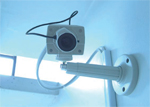
Just for the Record
Customer requirements help narrow the video recording field
- By Chris Johnston
- Jul 01, 2010
There are a variety of solutions for recording
video, including cameras and encoders
with built-in storage; embedded or PC-based
DVRs, NVRs and cameras; and encoders that stream
direct to storage without any intervening hardware.
The customer’s requirements help to narrow the
field during the selection process. The amount of cameras,
the number of facilities, the communications infrastructure,
the alarm handling needs and the degree
of integration with other systems, among other factors,
are important when designing a system.
Solutions for Common Applications
Smaller systems with just a few analog cameras often
need only a basic plug-and-play recorder. For other
small applications, a secure digital flash memory
card that can store days of recorded video in the
camera or encoder is adequate.
A customer who has analog cameras installed
and wants to expand the system with IP cameras will
benefit from a hybrid DVR. These DVRs can record
video from both analog and IP cameras and display
the video from each on one monitor. A hybrid system
with H.264 compression will reduce the amount of
storage required for recorded video.
For larger systems or customers that need continuous
recording at the highest resolution and frame rate,
it may be best to take advantage of direct attached
storage or storage area networks, which can hold large
amounts of data and are more cost effective.
A PC-based DVR or NVR may be required for
customers who need more extensive alarming and
interface capabilities or integration with other systems,
such as access control platforms, alarm panels
or license plate capture equipment. More advanced
embedded devices also can provide this functionality
with just one unit to set up, eliminating the need for
the separate server, PC client and storage components
that increase installation times by 50 percent. Embedded
systems also provide the benefit of reduced
maintenance costs, as there are no operating system
patches or anti-virus software to install and manage.
Management Companies Get an Upgrade
The ability to centrally operate multiple recording solutions
across a range of locations was one of the key
reasons security integrator The Safeguard System
Inc. selected a Bosch DVR-based solution for Pizza
Properties Inc. and QSR Burgers LLC. The restaurant
franchise management companies recently upgraded
their video surveillance systems from VCRbased
to DVR-based recording.
The franchise owners expanded camera coverage
in their 40 pizza and family entertainment locations
and 34 fast food hamburger dining establishments
throughout Texas, while also switching from VCR
to DVR technology. Now, each pizza and family entertainment
restaurant has 13 cameras that record
video to a Bosch DVR. The cameras capture video at
point of sale terminals, in game rooms, in the pizzerias
and outside offices, near safes and surrounding
the perimeters. Video is recorded by the DVRs when
motion is detected. As a result, video in high-activity
areas, such as the game rooms, is recorded regularly,
while video in areas with less activity, such as outside
the restaurant offices, is recorded less frequently.
This ensures the DVRs have adequate storage space
for important video that may need to be reviewed by
company management.
“By installing 12- and 18-channel DVRs in the
restaurants, we built in flexibility for expanding the
systems,” said Nick Thompson, manager of commercial
sales installation at The Safeguard System. “Store
employees no longer need to spend time switching cassette
tapes, and management does not need to rely on
restaurant employees to ensure video is recorded.”
Looking Back
With DVRs, archiving video also is more user friendly,
making it easier for the franchise management companies
to provide video as evidence in legal proceedings
if necessary. Images are displayed with the date, time,
location and camera name, which can be very valuable
in the event of a claimed slip and fall accident.
“With the technology we had in place prior to the
upgraded system, we would often miss critical points
of an incident in one of the restaurants,” said Sharon
Voelz, vice president of human resources and risk
management at Pizza Properties and QSR Burgers.
“The new cameras and DVRs provide better image
quality, making the recorded video more useful when
we need to investigate an occurrence.”
The DVRs’ user interface allows live and recorded
images from multiple locations to be viewed
from a single PC. Select company employees and
the companies’ external legal counsel can view several
cameras at once or watch full-screen video from
a specific camera via their own computers. They
also can search the recorded video based on
the date and time of an event or by using other
criteria to quickly find incidents
of concern. This eliminates timeconsuming
manual searches.
This article originally appeared in the issue of .